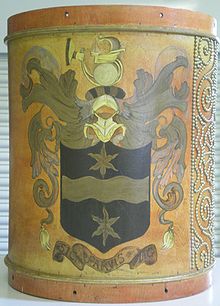



Military drums or war drums are all kinds of drums and membranophones that have been used for martial music, including military communications, as well as drill, honors music, and military ceremonies.
History
Among ancient war drums that can be mentioned, junjung was used by the Serer people in West Africa. The Rigveda describes the war drum as the fist of Indra.
In early medieval Europe, the Byzantine Empire made use of military drums to indicate marching and rowing cadence, as well as a psychological weapon on the battlefield since the End of Antiquity. However, in Western Europe, military drums were little observed until the time of the Crusades (p. 19) Western European armies likely first encountered drums used by Byzantine and Islamic military forces, the latter who used primarily their traditional kettledrums, and in battle found that the sound would particularly affect Crusaders' horses, who had not previously encountered them. By the early 13th century, Crusading armies began to adopt military drums and brought back the practice to the West.
The snare drum in particular began to be used in 13th Century Europe to rally troops, and to demoralize the enemy.
Use for military signaling
A military tattoo was originally a drum signal for soldiers' curfew. Other uses for military drums have been recruiting and calling for parley.
Ancient Fife and Drum Corps, as well as modern drum corps have been used by early modern armies for signaling and ceremonies, occasionally played by drummer boys in conflicts such as the American Civil War.
Drums in early modern warfare
From the early 16th century onwards drums became the usual means of passing orders on the European battlefield. Infantry and dragoons (mounted infantry) used side drums and heavy cavalry kettle drums for this purpose. Key signals by multiple or single drummers included general, call, prepare, march, assemble, advance, retreat, etc.
Final use in battle
At the outbreak of World War I in August 1914 drums were still in use on active service by some of the more conservative European military forces. These included the Austro-Hungarian K.u.K. Army whose infantry carried aluminium drums painted in pike-grey during the early weeks of combat. The unsuitability of such musical instruments for modern warfare was quickly realised and in September 1914 the drums were withdrawn, and the drummers transferred to other duties.
Civilian music
Over a period of time, Snare drums, as well as timpani, have been adopted into civilian classical and popular music.
Metaphor
In modern times, the term war drums is used as a metaphor for preparation for war.
See also
- Drummer (military)
- Fife (instrument)
- Carnyx
- Field music (military)
- March (music)
- Marching percussion
References
- "Origins of the War Drum?". 28 January 2012. Archived from the original on 12 October 2018. Retrieved 12 October 2018.
- Pryor-Jeffries, The Age of the ΔΡΟΜΩΝ: The Byzantine Navy ca 500-1204. Brill, 2006. ISBN 978-904740993-9
- Leo VI tr. Dennis, The Taktika of Leo VI: Revised Edition.Dumbarton Oaks, 2014. ISBN 978-0884023944
- John Norris, Marching to the Drums: A History of Military Drums and Drummers. Stround, Gloucestershire : Spellmount, 2012. ISBN 978-0752468792
- David Nicolle, Medieval Warfare Source Book. London 1995-6.
- "Who Used War Drums? : Media History Project : U of M". Archived from the original on 2013-04-13. Retrieved 2012-10-31. University of Minnesota on war drums
- "Archived copy". Archived from the original on 2016-03-04. Retrieved 2012-10-31.
{{cite web}}: CS1 maint: archived copy as title (link) - Page 599 Vol. 8, Encyclopaedia Britannica, Eleventh Edition.
- Jung, Peter (20 May 2003). The Austro-Hungarian Forces in World War I (1). Bloomsbury USA. p. 44. ISBN 1-84176-594-5.
- Grammaticas, Damian (10 May 2012). "China bangs the war drum over South China Sea". BBC News. Archived from the original on 12 October 2018. Retrieved 12 October 2018.
- Ltd, Market Oracle. "Ron Paul on Washington's War Drums for Syria :: The Market Oracle ::". www.marketoracle.co.uk. Archived from the original on 12 October 2018. Retrieved 12 October 2018.
- Jones, Terry (6 December 2011). "War drums are beating for Iran. But who's playing them? - Terry Jones". The Guardian. Archived from the original on 12 October 2018. Retrieved 12 October 2018.
This military-related article is a stub. You can help Misplaced Pages by expanding it. |